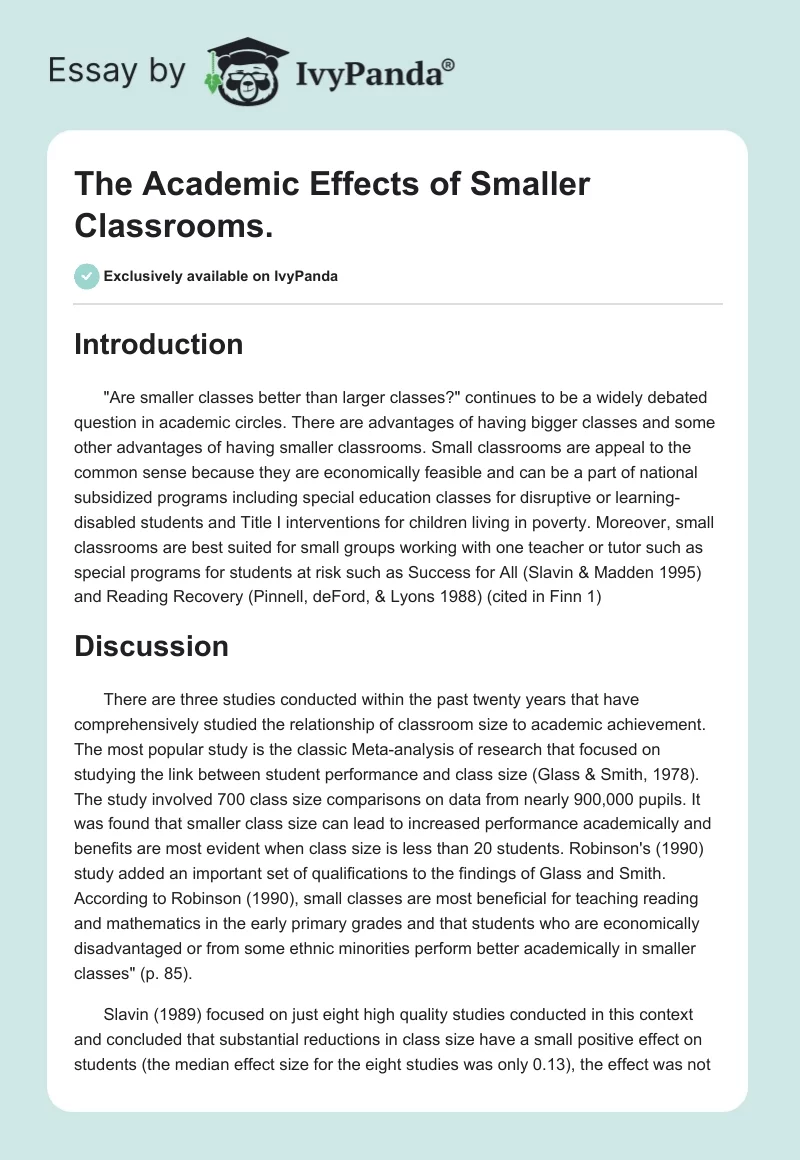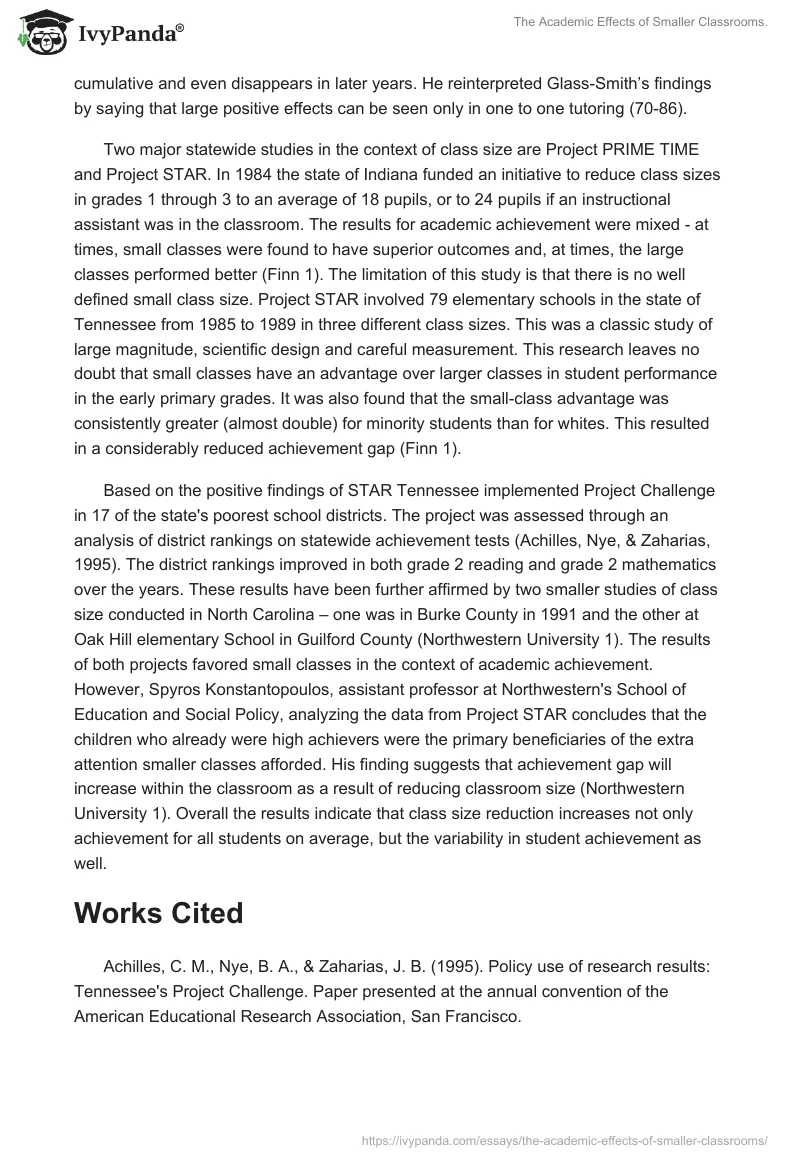Introduction
“Are smaller classes better than larger classes?” continues to be a widely debated question in academic circles. There are advantages of having bigger classes and some other advantages of having smaller classrooms. Small classrooms are appeal to the common sense because they are economically feasible and can be a part of national subsidized programs including special education classes for disruptive or learning-disabled students and Title I interventions for children living in poverty. Moreover, small classrooms are best suited for small groups working with one teacher or tutor such as special programs for students at risk such as Success for All (Slavin & Madden 1995) and Reading Recovery (Pinnell, deFord, & Lyons 1988) (cited in Finn 1)
Discussion
There are three studies conducted within the past twenty years that have comprehensively studied the relationship of classroom size to academic achievement. The most popular study is the classic Meta-analysis of research that focused on studying the link between student performance and class size (Glass & Smith, 1978). The study involved 700 class size comparisons on data from nearly 900,000 pupils. It was found that smaller class size can lead to increased performance academically and benefits are most evident when class size is less than 20 students. Robinson’s (1990) study added an important set of qualifications to the findings of Glass and Smith. According to Robinson (1990), small classes are most beneficial for teaching reading and mathematics in the early primary grades and that students who are economically disadvantaged or from some ethnic minorities perform better academically in smaller classes” (p. 85).
Slavin (1989) focused on just eight high quality studies conducted in this context and concluded that substantial reductions in class size have a small positive effect on students (the median effect size for the eight studies was only 0.13), the effect was not cumulative and even disappears in later years. He reinterpreted Glass-Smith’s findings by saying that large positive effects can be seen only in one to one tutoring (70-86).
Two major statewide studies in the context of class size are Project PRIME TIME and Project STAR. In 1984 the state of Indiana funded an initiative to reduce class sizes in grades 1 through 3 to an average of 18 pupils, or to 24 pupils if an instructional assistant was in the classroom. The results for academic achievement were mixed – at times, small classes were found to have superior outcomes and, at times, the large classes performed better (Finn 1). The limitation of this study is that there is no well defined small class size. Project STAR involved 79 elementary schools in the state of Tennessee from 1985 to 1989 in three different class sizes. This was a classic study of large magnitude, scientific design and careful measurement. This research leaves no doubt that small classes have an advantage over larger classes in student performance in the early primary grades. It was also found that the small-class advantage was consistently greater (almost double) for minority students than for whites. This resulted in a considerably reduced achievement gap (Finn 1).
Based on the positive findings of STAR Tennessee implemented Project Challenge in 17 of the state’s poorest school districts. The project was assessed through an analysis of district rankings on statewide achievement tests (Achilles, Nye, & Zaharias, 1995). The district rankings improved in both grade 2 reading and grade 2 mathematics over the years. These results have been further affirmed by two smaller studies of class size conducted in North Carolina – one was in Burke County in 1991 and the other at Oak Hill elementary School in Guilford County (Northwestern University 1). The results of both projects favored small classes in the context of academic achievement. However, Spyros Konstantopoulos, assistant professor at Northwestern’s School of Education and Social Policy, analyzing the data from Project STAR concludes that the children who already were high achievers were the primary beneficiaries of the extra attention smaller classes afforded. His finding suggests that achievement gap will increase within the classroom as a result of reducing classroom size (Northwestern University 1). Overall the results indicate that class size reduction increases not only achievement for all students on average, but the variability in student achievement as well.
Works Cited
Achilles, C. M., Nye, B. A., & Zaharias, J. B. (1995). Policy use of research results: Tennessee’s Project Challenge. Paper presented at the annual convention of the American Educational Research Association, San Francisco.
Finn, Jeremy D. (1998). Class Size and Students at Risk – What Is Known? What Is Next? A Commissioned Paper. U.S. Department of Education, OERI, National Institute on the Education of At-Risk Students, 1998. Web.
Glass, G. V., & Smith, M. L. (1978). Meta-analysis of research on the relationship of class size and achievement. San Francisco: Far West Laboratory for Educational Research & Development.
Northwestern University (2008). Class Size Alone Not Enough to Close Academic Achievement Gap. ScienceDaily. 2008. Web.
Pinnell, G. S., deFord, D. E., & Lyons, C. A. (1988). Reading recovery: early intervention for at-risk first graders. Arlington, VA: Educational Research Service.
Robinson, G. E. (1990). Synthesis of research on effects of class size.” Educational Leadership. 47(7). 80- 90.
Slavin, R. E., & Madden, N. A. (1995). Success for all: Creating schools and classrooms where all children can read. NSSE Yearbook, Part 1. Chicago, IL: University of Chicago Press, 70-86.


